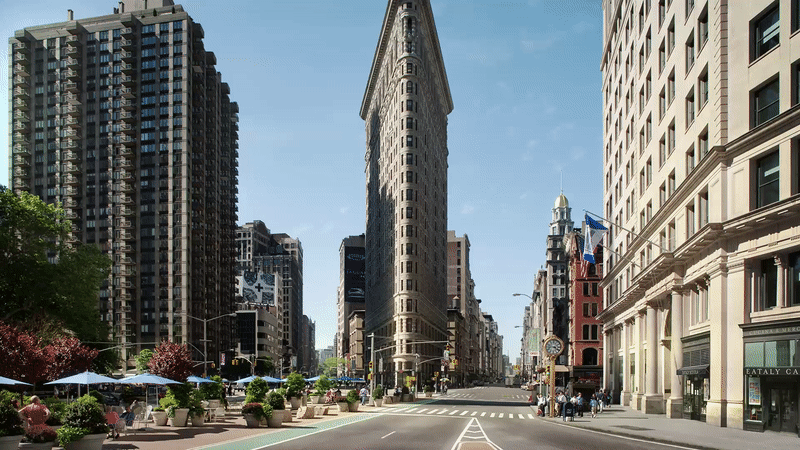
With its Green Block concept, global design firm WATG envisioned the intersection of Manhattan’s Flatiron building as a green, carless, alfresco-centric streetscape. (Courtesy WATG)
Our upcoming issue of Convene explores how the pandemic has reshifted our priorities and reflects the efforts of our editorial team to seek out the silver linings in the face of human suffering and economic devastation. One area we didn’t cover: How COVID-19 and the resulting lockdowns have changed the way we’re thinking about the future of our cities.
This week, I received a press release about a new urban planning solution by global design firm WATG that envisions a greener New York City — one, the company said, “that underscores the unforeseen positives revealed during the pandemic.”
“As the coronavirus lockdown took force of major metropolises, an unusual thing happened across the world’s best cities: the sounds of taxi horns hushed, the skies cleared and the gloomy haze of pollution lifted,” according to the press release. “There were reports of city dwellers waking up to the song of birds, rain pouncing on windows, and the rustling of leaves. As New York City begins to peek its head out from its four-month hibernation — unlocking bodega doors, flipping open blinds, and turning around its ‘Open for Business’ signs — there are obvious unintended positives that almost instantaneously took hold of the city that never sleeps. New Yorkers should not forget what a cleaner city looks like, and fight to find a way to adopt new ways of living that contribute to a healthier, safer, more breathable way of life.”
WATG’s concept, called “Green Block,” has been recognized by Urban Design Forum as a solution for its “City Life After Coronavirus” series, “which focuses on organizations advancing a just and equitable recovery for communities most impacted by the crisis.”
The internal innovation competition focused on how WATG’s team of urban planners, landscape architects, and designers could use their skills and insights gained from the pandemic, “to transform urban spaces in a post-pandemic world for the better.”
Focusing on the intersection of Manhattan’s Flatiron building, Green Block is a green, carless, alfresco-centric, streetscape vision for New York’s streets, according to the press release. “Our cities have been long overdue for transformation and, as some people flee for greener landscapes in the wake of COVID-19, Green Block proves that you don’t need to sacrifice one for the other,” said WATG’s John Goldwyn, the master planner and landscape artist behind the concept. “We actually can, in fact, have both the urban and the green lifestyle.”
Goldwyn said that urban planners and designers need to help communities become more “self-reliant,” by creating systems the help current residents and future generations thrive. “Communities that are resilient with strong, built-in systems of support,” he said, “become even stronger during times of crisis.”
Planning Cities From a Diversity Perspective
In addition to the coronavirus health crisis, the U.S. has also been reckoning with a racial crisis. A recent Fast Company article — “Meet the Black Design Collective Reimagining How Cities Get Built” brings to light how the voices of communities of color are often absent in urban planning efforts. The article focuses on how BlackSpace, a group of 200 architects, designers, artists, and urban planners, is working to change that.
Not only are the urban planning, architecture, and development fields notoriously white (only 2 percent of licensed architects are Black, and as of 2016, less than 15 percent of the American Planning Association’s members identify as people of color), but urban development policies and practices have cut communities of color out of important conversations. Practices like “community meetings scheduled at times that are difficult for working people to attend,” and “preservation efforts that associate historical value with economic prosperity” tend to disenfranchise Black communities and other nonwhite groups, according to the article. “They continue to result in discriminatory outcomes, whether planners, designers, and developers realize it or not.”
Enter the nonprofit BlackSpace, which is a testament to the power of events to create a movement. The group traces its roots to a 2015 conference, Black in Design, organized by the African American Student Union at the Harvard Graduate School of Design. “As folks from disparate fields,” said Emma Osore, a BlackSpaces cofounder, “we weren’t used to seeing this interdisciplinary group focused on various ideas of Blackness across time and space. We were so enamored by the ways we were learning, the types of things we were learning, and the people in the room. And we realized we want more of this. We want to get together across disciplines to center Blackness in public space….”
Several of the attendees realized that they lived in close proximity to each other in Brooklyn, New York, and to try to keep the conversation from the conference going, they decided to meet again, informally for brunches and meetups. The group grew organically — part brainstorm but also part support group, Osore said.
Among other initiatives, through workshops with local groups, BlackSpace has led the creation of a tool kit that can be used to collect and preserve local histories — particularly of Black culture — in neighborhoods, that had often been ignored,.
BlackSpace’s influence has expanded outside of New York, with two official affiliate groups forming in Chicago and Oklahoma City — again, as a direct result of the Black in Design conference at Harvard. At the second iteration of this conference in 2017, Vanessa Morrison, a social planner and crisis response professional based in Oklahoma City, said she learned about BlackSpace during a conference presentation and knew that she wanted to bring that work back with her to Oklahoma.
Michelle Russell is editor in chief of Convene.
